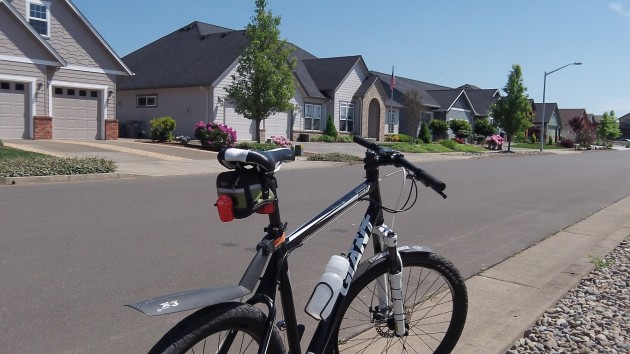
All but ignored by the legislature, and glad of it.
Oregon legislators didn’t give much thought to bicycles this session, and that’s all right. Given lawmakers’ drive to make ever more laws, being ignored by them is not a bad thing. The session in Salem is just about over, and it looks like bikes and their riders are being left pretty much alone.
At the beginning, back in February, a couple of bills were introduced to register and tax bicycles and use the proceeds on bikeways. At least one of those Senate bills also would have outlawed the spending of road money on bike paths and lanes. Neither bill even got a hearing, so the legislators obviously were in no mood to repeal Oregon’s landmark bike bill, now more than 40 years old. (Republican Rep. Don Stathos of Jacksonville got the bill through the 1971 legislature. It requires that when the state, counties and cities fund road projects they must allocate a reasonable amount to bike-related facilities.)
One bill that did make it into law and that will help is Senate Bill 533A. It allows motorcyclists and bicyclists to proceed through a stop light after waiting until it’s safe and the signal has not turned green. Almost by definition, this happens only when traffic is very light, and that’s when cyclists already do what the new law allows. So it’s no big deal, but a nice touch anyway.
That brings us to House Bill 3255. It started out as requiring cyclists to wear reflective clothing when they’re riding after dark. Then it was amended to drop the garment rule and require instead that bicycles have a red taillight visible for 600 feet when visibility is low, and the House passed the bill 44-14. But before the Senate Business and Transportation Committee, a lawyer testified that this might require people to buy new taillights for about 2 million Oregon bikes, and in any case it wasn’t necessary because the law already requires either a taillight or a red rear reflector, along with seven other reflectors, when bikes are sold.
Maybe this sensible advice got the Senate committee’s attention, because the panel has taken no action on the bill. So maybe on the issue of visibility, cyclists will be allowed to use common sense — make yourself highly visible anytime but especially after dark — without the benefit of yet another law. (hh)


Legislators leave cyclists alone
All but ignored by the legislature, and glad of it.
Oregon legislators didn’t give much thought to bicycles this session, and that’s all right. Given lawmakers’ drive to make ever more laws, being ignored by them is not a bad thing. The session in Salem is just about over, and it looks like bikes and their riders are being left pretty much alone.
At the beginning, back in February, a couple of bills were introduced to register and tax bicycles and use the proceeds on bikeways. At least one of those Senate bills also would have outlawed the spending of road money on bike paths and lanes. Neither bill even got a hearing, so the legislators obviously were in no mood to repeal Oregon’s landmark bike bill, now more than 40 years old. (Republican Rep. Don Stathos of Jacksonville got the bill through the 1971 legislature. It requires that when the state, counties and cities fund road projects they must allocate a reasonable amount to bike-related facilities.)
One bill that did make it into law and that will help is Senate Bill 533A. It allows motorcyclists and bicyclists to proceed through a stop light after waiting until it’s safe and the signal has not turned green. Almost by definition, this happens only when traffic is very light, and that’s when cyclists already do what the new law allows. So it’s no big deal, but a nice touch anyway.
That brings us to House Bill 3255. It started out as requiring cyclists to wear reflective clothing when they’re riding after dark. Then it was amended to drop the garment rule and require instead that bicycles have a red taillight visible for 600 feet when visibility is low, and the House passed the bill 44-14. But before the Senate Business and Transportation Committee, a lawyer testified that this might require people to buy new taillights for about 2 million Oregon bikes, and in any case it wasn’t necessary because the law already requires either a taillight or a red rear reflector, along with seven other reflectors, when bikes are sold.
Maybe this sensible advice got the Senate committee’s attention, because the panel has taken no action on the bill. So maybe on the issue of visibility, cyclists will be allowed to use common sense — make yourself highly visible anytime but especially after dark — without the benefit of yet another law. (hh)
Tags: bicycles, bicyclists, bike bills, Oregon legislature